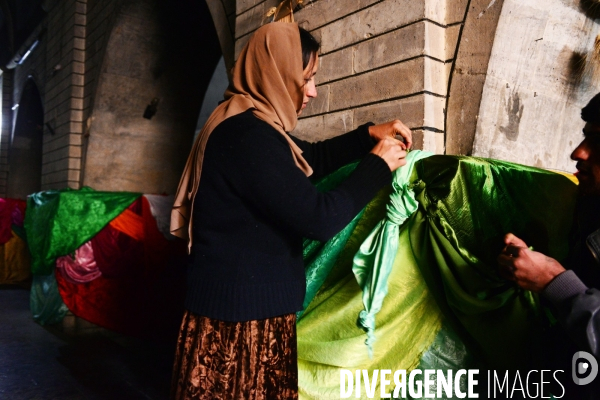
Lalish the holiest shrine in the Yazidi faith, Lalish lieu saint de pèlerinage dans la foi Yazidi,
© Alfred YAGHOBZADEH / Divergence
A woman Yazidi ties and unties a knot in a piece of colorful fabric a ritual at a shrine covering the tomb of a revered Yazidi sheikh in the holy village Lalish temple, the holiest shrine in the Yazidi faith,. Each knot represents a prayer, and Yazidis believe that untying the knot of an earlier pilgrim will grant that person his or her wish. The Yazidis are a Kurdish ethno-religious community whose syncretic but ancient religion Yazidism (a kind of Yazdânism) is linked to Zoroastrianism and ancient Mesopotamian religions.They live primarily in the Nineveh Province of Iraq. Additional communities in Armenia, Georgia, and Syria have been in decline since the 1990s as a result of significant migration to Europe, especially to Germany. The Yazidis are monotheists, believing in God as creator of the world, which he has placed under the care of seven holy beings or angels, the chief of whom is Melek Taus, the Peacock Angel. The Peacock Angel, as world-ruler, causes both good and bad to befall individuals, and this ambivalent character is reflected in myths of his own temporary fall from God's favor, before his remorseful tears extinguished the fires of his hellish prison and he was reconciled with God. This belief builds on Sufi mystical reflections on the angel Iblis, who proudly refused to violate monotheism by worshipping Adam and Eve despite God's expressed command to do so. Because of this connection to the Sufi Iblis tradition, some followers of other monotheistic religions of the region equate the Peacock Angel with their own unredeemed evil spirit Satan, which has incited centuries of persecution of the Yazidis as "devil worshippers." Persecution of Yazidis has continued in their home communities within the borders of modern Iraq, under fundamentalist Sunni Muslim revolutionaries. In August 2014 the Yazidis were targeted by the Islamic State of Iraq and the Levant in its campaign to "purify" Iraq and neighboring countries of non-Islamic influences. A displaced woman, who fled from Islamic State violence in Mosul, makes bread in refugee camp on the outskirts of the Kurdish city of Arbil December 1, 2014. They used to be symbols of an oil-fuelled boom, but the unfinished buildings in Iraq's Kurdish north are now crammed with people fleeing violence in the rest of the country.Of the two million people displaced by Islamic State offensives in Iraq this year, almost half sought refuge in Kurdistan, inflating the semi-autonomous region's population by around 20 percent and putting acute strain on its resources. Lalish-Iraq
Lieu : LALISH, IRAQ
Mots clés : Iraq, Irak, dohuk, kurdistan, Lalish temple, yézidi, yézidisme, Yazidism, Yazidi, sanctuaire, cour de pierre, rituels, paon, religieux, ange paon, émanation de Dieu, foi, minorité, Sinjar, tombe, cheikh Adi bin Musafir, temple saint, yézidi minorité religieuse, secte, spirituelle, persécution, Melek Taus, Tawsi Malik, militants islamistes, EIIL, EL, Etat islamique d'Irak et la Syrie, Etat islamique, tomb, Sheikh Adi bin Musafir, zoroastrian, religion, Peacock, Peacock Angel, Peacock King, holy temple, Yazidi religious minority, sect, Spiritual, worship, persecution, sanctuary, stone courtyard, religious, faith, unties, knot, piece, colorful, color, fabric, yellow, white, green, dénoue, noeuds, pièce, coloré, couleur, tissu, jaune, vert, minority, ISIS, IS, Islamist militants, Islamic State of Iraq and Syria, Islamic State, alfred yaghobzadeh